NAMI Family Support Group Model Overview
This content provides an insightful introduction to the NAMI family support group model, emphasizing the importance of having a structured model to guide facilitators and participants in achieving successful support group interactions. It highlights the need for a model to prevent negative group dynamics, explains the reasons for individuals to attend support groups, outlines the expectations and desires of group members, and details the responsibilities of a capable facilitator. The content also covers key elements of the NAMI Family Support Group model, including strategies, structures, and group processes that ensure effective support group meetings.
Download Presentation

Please find below an Image/Link to download the presentation.
The content on the website is provided AS IS for your information and personal use only. It may not be sold, licensed, or shared on other websites without obtaining consent from the author.If you encounter any issues during the download, it is possible that the publisher has removed the file from their server.
You are allowed to download the files provided on this website for personal or commercial use, subject to the condition that they are used lawfully. All files are the property of their respective owners.
The content on the website is provided AS IS for your information and personal use only. It may not be sold, licensed, or shared on other websites without obtaining consent from the author.
E N D
Presentation Transcript
Facilitator Training Introduction to the Model
Why do we need a model? To help the facilitator avoid the negative group dynamics that can limit the success of a support group. A support group can operate with a will of its own and take the group down an unproductive path Sometimes a group can pull even the most experienced facilitator off course
Why do people go to a support group? To leave feeling better than when they came To feel that they contributed and that they were supported To feel that they have something in common with others
What do they want at a support group? A safe place To not be judged Boundaries that are enforced Capable facilitators
NAMI Family Support Groups Are led by trained facilitators, using: Strategies Structures Processes They are capable facilitators, not therapists!
A capable facilitator Asks group members to agree to share responsibility for maintaining the Group Guidelines Sustains clear membership boundaries Clarifies goals, that is, our Principles of Support Identifies the common issues of the group in a positive and optimistic manner Develops communication skills that encourage group participation
NAMI Family Support Group strategies, structures and group processes This model assures an effective support group meeting.
NAMI Family Support Group model 5 Strategies Communication skills that AID US 4 Structures Agenda Group Guidelines Principles of Support Emotional Stages 3 Group Processes Tough Topics Group Wisdom Problem Solving
Five strategies Communication skills that AID US Affirm Inquire Direct Understand Support
Four structures Agenda Group Guidelines Principles of Support Emotional Stages
Three group processes Tough Topics Group Wisdom Problem Solving
Rules when using the NAMI Family Support Group model Facilitators always use the Facilitator Guides Facilitators pay close attention to the steps and cardinal rules on each guide
Agenda Always start and stop on time Always start Check In with the facilitators to model the 1 to 2 minute time limit
Group Guidelines Don t scold; be directive Always model respect for the member being disrespectful Remember, it s normal for people to forget guidelines in support groups
Principles of Support Never lecture or instruct the group about principles Get the group talking about these universals
Emotional Stages Never tell a participant where they are Always ask them what stage they think they are in Direct the group s attention to what the participant needs in that stage and discuss how those needs can be met
Tough Topics Never avoid discussing a traumatic event when it comes up in a support group Traumatic events need to be detoxified The NAMI Family Support Group process for handling these tough topics is often called Hot Potatoes
Group Wisdom Group Wisdom is a process through which participants share resources and knowledge gained from past experiences Always ask members what they know that is constructive, practical and helpful
Problem Solving When doing Problem Solving, you will shift to a directive leadership style Do not use the Problem Solving Process for illness-related symptoms or non- responsiveness to medications
Remember, as a capable facilitator you are present to help the group meet its needs, not to have the group help you meet yours
What to expect at this training To learn by doing To make mistakes; it s part of the learning process To practice the strategies, structures, and group processes outlined for you in this presentation To have fun!






























